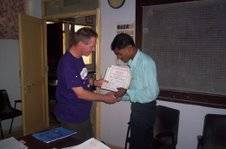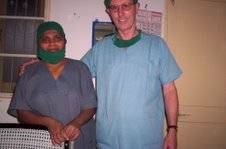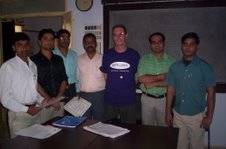Dublin Bus Driver Aids The Blind
By
Mattie Lennon
Irish Charity in India
Three years ago my work colleague
Christy Butler paid a social visit to India. So awed,
moved and disturbed was he by the poverty, hardship and
disease that he decided to do something about it. He
says,
"I was in India in 2004 on a private visit in
Gujarat State. I was overcome by the hospitality and
welcome I received from the people I met and at the same
time appalled at the living conditions of many. On my
return home I decided to check NGOs and charities to see
if I could help in any way. I selected Sightsavers
International and for the past 4 years have been
organising fundraising events for this charity.
Unnecessary blindness combined with abject poverty made
life extremely hard for many people and yet it cost so
little to make a difference. For 25 euro a person’s
eyesight can be restored. A simple cataract operation
takes just 20 minutes. That’s all it takes to give
someone’s dignity back and help them to become involved
once more in village life.”
On the June weekend 2007 he organized
a sponsored Bus-Pull. A number of his fellow workers at
Dublin Bus pulled a bus from Donnybrook to the City
Centre. €6,000 was raised. Isn't it mind boggling to
think that such a modest sum could enable an incredible
240 people to once again see the work of the Creator and
lead a normal life?
Christy Butler in India November 2007
In November 2007 Christy spent three
weeks in India and this is what he has to say about
it:
"On a recent visit to India, arrangements were made by
Sightsavers International, for me to visit one of their
partners' clinics in Gujarat State, near the town of
Bharuch. I had only dreamed of such a visit and was eager
to see for myself the amazing work being carried out by
Sightsavers for the needlessly blind of the developing
world.
"As the country's leading charity combating blindness
in the developing world, its vision is of a world where
no-one is needlessly blind, is a huge task. It works with
its partner organisations in the poor, little served
communities. Words that spring to mind as I entered SEWA
Rural Clinic/Hospital, a 30-minute drive from Bharuch
Railway Station in the Jhagadu District of South Gujarat.
I had been met by Dilif Patel, my guide for the day, and
after a tour of the clinic/hospital, which included
maternity, outpatients, eyecare centre and a school, we
had lunch in a self-service canteen, where the Director,
doctors, nurses, cleaning staff all sit and eat together.
Joking and talking about their daily tasks. Would this
happen here?
"Following lunch I was shown a DVD of the work of the
clinic/hospital. SEWA Rural is more a vocation, a way of
life. Its motto, "For the poorest of the poor" is very
appropriate. Its catchment area comprises 2 million
people from 130 villages, 99.9 % of whom are poor, and
covers an area bigger than Leinster. Then out into the
bush to see some of the work involving Sightsavers
International and the Outreach Programme. Accompanied by
Dr Adjid, an ophthalmologist, and Adjuntra Sunvaa and
Mahesh, part of the Outreach Team, we first came across a
village. One of the huts had a sign over the door for
which the basic translation is 'This person is totally
blind and has been helped by Sightsavers International.'
The woman in her little shop is now a respected member of
the village and is able to provide for herself.
"The next call brought us to a field worked by a blind
man. Although totally blind, he is well able to harvest
his crop and he too is able to provide for his family.
Sightsavers International helped to set him up with the
purchase of the land.
"In another village we met a totally blind woman who
runs an electric flour mill. The village had come to
depend on her to run the mill. She was able to provide
for her family and to become a 'valuable member of the
community' again, with the help of Sightsavers
International and SEWA Rural. These are just three
examples of the work carried out by the Outreach
Programme and Sightsavers International.
"The elderly believe that cataract is a disease that
comes from old age and have to be coaxed to come to the
clinic/hospital for treatment. As they are found and
examined, a 20-seater bus provided by Sightsavers
International to help the Outreach Team, ferries them to
the clinic for treatment, some from 100 km away. After
the operation they are returned to their village. A
follow on check up takes place by an ophthalmologist in a
Landrover provided by Sightsavers International.
"Due to the vast area covered by the clinic, the bus
and Landrover and essential to the smooth running of the
Outreach Programme, who have a great rapport with totally
blind people. A memorable day for me as I witnessed, at
first hand, the magnificent work of the people of SEWA
Rural and Sightsavers International. The staff of the
clinic, along with the Outreach Team, are a truly
fantastic group of devout, professional and caring people
working with the poorest of the poor, and as I reflected
on the day, I felt that I had walked with saints.
"Early the following morning, I met children as they
arrived for school at the clinic. I had a large box of
coloured pencils which I presented to the teacher for use
in the classroom.
"Into the clinic, where 20 new arrivals from last
night were being prepared for surgery. I then attended an
operation for the removal of a cataract. A little
apprehensive at first, but after scrubbing up my initial
fears receded and I became engrossed in the operation. I
followed the ophthalmologist's delicate movements on a TV
above the operating table, as he removed the cataract
using tiny instruments, through the telescope. It looked
simple, took less than 20 minutes and cost about '25.
Such a small amount to restore someone's eyesight. Twenty
more operations followed. Bandages were placed over the
affected eye. After counseling, each patient was provided
with eye drops and dark glasses to help them over the
next day or two.
"Afterwards, I went back out into the bush to visit a
primary health care centre supported by Sightsavers
International. Located some 50 km from the main clinic,
it is manned 24/7 by a young man. He lives on the
premises with his wife and son He is a paramedic with
huge responsibilities. In the front line so to speak of
the Outreach Programme, the facility has a full operating
theatre. For serious injuries a doctor would be summoned
from the main clinic. Once again, equipment and transport
plays a major role in the successful running of this
Primary Care Facility. This is more than a job to this
young man, available 24 hours a day, 7 days a week, for
the poorest of the poor. It's a vocation! I was honoured
to meet him. He did not wish to have his photo taken or
his name mentioned.
"Returning to the clinic I addressed the staff,
encouraging them on to greater deeds and had the
privilege of presenting awards to three young men. They
too would be setting off the following day to man a
primary care facility. So much depends on them.
"Dr Adjid, 29 years of age, an ophthalmologist, along
with Adjuntra Sunva, Dilip Patel and Mahesh, deserve much
praise for their work and commitment. Dr Adjid has given
up so much, sacrificed everything, just to be part of the
SEWA Rural Community. He, along with the Outreach Team
deserve a Nobel Prize for their work.
"Following a long discussion with Dr Uday and having
been presented with a DVD of the work carried out by SEWA
Rural clinic I proceeded to Bharuch town, where I boarded
a bus for a five-and-a-half hour journey to my base in
Ahmedabad. I had an amazing time, a life-changing time,
at the clinic. It gave me a greater perspective of the
work of Sightsavers International and its partner
organisations in Jhagadia District of Bharuch and also on
life itself. For the five-and-a-half hour journey I was
contemplating on my fundraising plans for the coming
year, my major objective being the Dublin Bus Pull, to
make it bigger than ever and to make the people of Dublin
more aware of the fantastic work being carried out by
Sightsavers International in the developing world.
"Unnecessary blindness is hard but combined with
poverty and harsh living conditions, it makes life
unbearable. Having witnessed at first hand the work of
Sightsavers International and SEWA Rural clinic in just
one small corner of the developing world I shall
endeavour to give more time, energy and commitment to my
fundraising activities in the future.
"What we do today echoes in eternity."
Christy Butler
What have Sightsavers done to
date?
In 2006 millions of people have been seen
and treated. 4,670,008 people they have seen by their
local partners, and 3,102,769 people treated as a result.
Eye operations: They supported
277,393 eye operations.
River blindness protection:
14,208,655 people they protected against river blindness
in Africa.
Training of workers: They
supported the training of 65,853 workers, ranging from
community volunteers to specialist teachers, nurses and
cataract surgeons.
Social inclusion: Their
partners helped 9,514 people who are blind to lead
independent lives by training in mobility, orientation
and life skills.
Education: They supported 4,822
children who are visually impaired to
attend.
You
can contact Sightsavers at:
98, Patrick Street,
Dun Laoghaire, Co. Dublin
or go to: www.sightsavers.ie
Click on author's byline for bio and list of other works published by Pencil Stubs Online.
|





